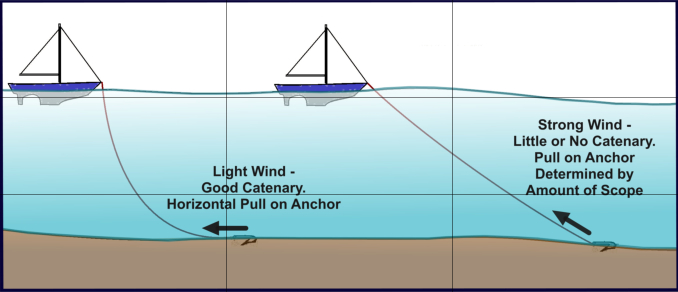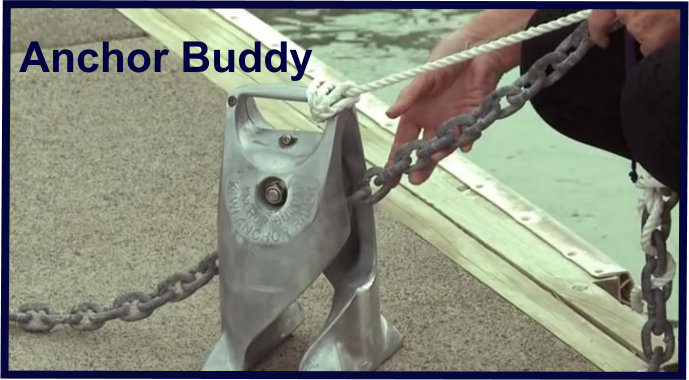The Blue View - Chums, Angels and other Buddies
/An anchor has its maximum holding power when the rode pulls on it in a horizontal direction. The closer to horizontal, the better it will hold. That's why the amount of scope (the ratio of the length of rode deployed to the depth of the anchorage) is such an important factor in how well an anchor holds. With a 3:1 scope, the maximum angle of pull on the anchor is 19.5º; at 5:1 the angle is 11.5º; and at 7:1, the angle is 8.2º.
The catenary effect created by the weight of the rode also causes the pull on the anchor to be more horizontal. If you look at the arc of the anchor rode in the illustration, you can see that, in light winds, the end of the rode nearest the anchor lies on the seabed. As the wind increases, the catenary effect lessens. Eventually, if the wind becomes strong enough, the rode will form a straight line between the bow and the anchor.
The weight of the rode and size of the boat determines how much wind is required to overcome the catenary effect. If the rode is all rope, it takes very little wind to pull the line taut. For example, if Nine of Cups, a 45 foot (14m) boat, was anchored in 20 feet (6m) with 100 feet (30m) of rope rode deployed, it would take less than 10 knots of wind to overcome the catenary of an all rope rode. If the rode was 3/8” (10mm) chain, it would require almost 25 knots of wind before the chain became taut.
The catenary effect can be increased by adding weight to the rode. This can be accomplished by letting out more chain, and/or attaching a weight to the rode. These weights are referred to by a number of different names – chums, buddies, angels, anchor riders and kellets to name a few.
We've always called these weights 'chums', and there are quite a number of very experienced voyagers who firmly believe in their use. We know a few who will use a chum every time they anchor, but most only use one when the wind begins to pick up or when in a tight anchorage. A chum will reduce the amount of swinging a boat does when the wind is light to moderate, and will increase the catenary of the anchor rode when it is necessary to use reduced scope, as is often the case when there are a number of other boats anchored close by. No matter how big the chum, however, if the wind gets strong enough, it will eventually overcome the catenary effect, and the angle of pull on the anchor will depend totally on the scope.
There are a few purpose-made chums available. One that is especially easy to use is the Anchor Buddy, made in New Zealand. (It is marketed in the U.S. by Quickline USA ). Once you get the hang of using it, it can be attached and detached in a minute of two.
You can also make one quite easily. To make a 30 lb (13.6kg) chum, you will need a 1.5 gallon or larger container – a 2 gallon plastic ice cream container would be perfect if you can find one, or a 5 gallon paint bucket will do. You will also need a half bag of concrete, and a large galvanized eye hook. After you and your friends eat the ice cream, mix the concrete and pour it into the container. Before the concrete sets, push the hook down into the concrete until just the eye protrudes. Allow it to set and cure for a week or so.
To deploy it, you will need a very large shackle and 50-100 feet (15m-30m) of line. Tie one end of the line to the eye hook. After the anchor is set, use the shackle to attach the chum to the anchor rode. You want the shackle to be able to slide up and down the rode – do not shackle the chum to a link of chain if using chain rode. Next, let out enough line so that the chum will be just above the bottom at low tide and secure the line to a cleat.
When it is time to retrieve the chum, it is easy to pull the chum back up the rode if there is tension on the anchor rode. If the wind isn't blowing hard enough to tension the rode, put the boat in slow reverse until the rode is taut, then pull the chum up the rode. Undo the shackle and stow the chum.






